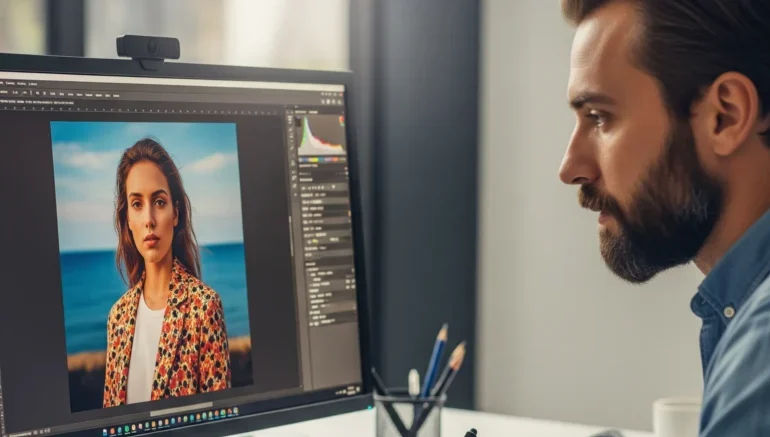
Top 5 Photo Editing Mistakes You Should Avoid
The art of photography is only half the battle in improving your skills. After you take that one perfect shot, the real work begins: editing. A well-edited photo turns a good image into a great one; at the same time, common photo editing mistakes will ruin an otherwise great photograph in no time. Having at hand such pitfalls will be important to achieve polished, professional results.
In this blog, we will not only go through some of the common photo editing mistakes but also take a look at some really professional tips on how to avoid them. Some very common mistakes include over-editing, wrong color balance, poor background details, and inconsistency in style that sells one’s work short. We dive into how these photo editing mistakes will make one lose the overall effect of an image and their effective remedies.
Learning how to identify such common mistakes and apply appropriate techniques thus serves only to improve your image without compromise on its natural beauty. Be you a novice in the field searching for some improvements in your editing prowess or a pro photographer who would like to refine his workflow, being aware of such pitfalls are important in perfecting your edit and achieving the best possible results.
Stay tuned as we give you practical tips and tricks that will help you avoid these editing mistakes and bring your photography to a new level. That way, you can ensure that your images are appearing outstanding, yet staying true to the very original idea you had in the first place.
Common Photo Editing Mistakes
Many photographers fall into the habit of ignoring some simple rules during editing, which then becomes one of the photo editing mistakes most done. These mistakes do affect your images in a big way. One of the common mistakes is over-editing wherein too many adjustments have been made in the form of over-sharpening or extreme contrast changes and thus the images start to look unnatural and over-processed. This, in the process, causes your photo to lose its natural charm and authenticity.
Another mistake most people make is not considering the original quality of the photo. Even the best editing techniques are incapable of fully fixing issues in case the first shot was badly taken, low-resolution, or some other failure in shooting. Let’s say, trying to correct a blurry image with heavy sharpening will result in far from a clear picture.
The other important mistake involves wrong color balance, which will directly impact your photo’s mood and accuracy. Poor color adjustment might give your image unnatural hues or an imbalanced look that takes away from the complete effect of a picture. The common mistakes include not being able to pay attention to background details. An interfering and messy background may steal the thunder from your subject itself and shall impact negatively on the composition and focusing of your image.
Understanding these basic editing mistakes will allow you to better improve your photos without losing their origin. Pay more attention to the subtlety and accuracy of adjustments and keep the quality of the original for professional and high-quality results.
Over-Editing as a Photo Editing Mistake
 The most common mistake that happens in photo editing is over-editing. Photographers can get too eager and apply too much adjustment, making the image look unnatural. For example, over-sharpening invites unwanted halos around the edge, while too much contrast will make a picture lose detail in its shadow and highlights. First of all, avoid over-editing by being subtle. Improve the natural beauty of an image without changing its looks altogether. Remember, sometimes less can be more, and the image should just pop rather than overwhelm.
The most common mistake that happens in photo editing is over-editing. Photographers can get too eager and apply too much adjustment, making the image look unnatural. For example, over-sharpening invites unwanted halos around the edge, while too much contrast will make a picture lose detail in its shadow and highlights. First of all, avoid over-editing by being subtle. Improve the natural beauty of an image without changing its looks altogether. Remember, sometimes less can be more, and the image should just pop rather than overwhelm.
Tips to Avoid Over-Editing
- Make changes gradually using adjustment layers so you can tweak settings safely without permanently altering the original photo. This gives you more control and flexibility while editing.
- Frequently toggle between the edited version and the original to see the difference. This helps you judge if your changes are keeping the photo natural and realistic.
- Share your edits with friends, colleagues, or mentors to get fresh perspectives. They can help you spot if anything looks overdone or unnatural, ensuring your portrait stays balanced.
Strategies to Improve Image Quality Before Editing
- Ensure your camera settings (ISO, aperture, shutter speed) are optimized for the shooting conditions to take high-quality images from the start.
- Use noise reduction and sharpening tools sparingly to boost the image quality. Avoid excessive adjustments that can introduce artifacts.
- If your image is slightly out of focus or poorly composed, crop strategically to focus on the strongest parts of the photo and improve overall quality.
Incorrect Color Balance
 The mistake of color balance is a common error that can radically affect the mood and feel of your image. For example, a picture that contains too much yellow or too much blue at times may look unnatural or uninviting. While color balancing, make small changes in steps. Take care with saturation: if overused, colors appear unnatural; if underused, your image will look dull. Use tools like white balance correction in order to achieve natural colors and make sure that your image conveys the mood you want it to.
The mistake of color balance is a common error that can radically affect the mood and feel of your image. For example, a picture that contains too much yellow or too much blue at times may look unnatural or uninviting. While color balancing, make small changes in steps. Take care with saturation: if overused, colors appear unnatural; if underused, your image will look dull. Use tools like white balance correction in order to achieve natural colors and make sure that your image conveys the mood you want it to.
Techniques for Correcting Color Balance
- Invest in color calibration tools for your monitor to ensure accurate color editing.
- Apply subtle color grading to achieve the desired mood without distorting the natural colors of the image.
- Adjust individual color channels (red, green, blue) to fine-tune the overall color balance and correct any color cast.
Neglecting Background Details
 The background can be a deal-breaker in the making of an image, yet it is usually ignored when it comes to editing. A messy or distracting background can take the viewer’s attention away from the main subject. For instance, in a portrait with a busy background-the subject may get hidden behind it. Give equal attention to the background: clean up distractions, correct exposure, and sharpen contrast to maintain attention towards your subject. On certain occasions, cropping or blurring the background will sustain visual interest.
The background can be a deal-breaker in the making of an image, yet it is usually ignored when it comes to editing. A messy or distracting background can take the viewer’s attention away from the main subject. For instance, in a portrait with a busy background-the subject may get hidden behind it. Give equal attention to the background: clean up distractions, correct exposure, and sharpen contrast to maintain attention towards your subject. On certain occasions, cropping or blurring the background will sustain visual interest.
Tips for Effective Background Editing
- Use Gaussian blur to soften distracting background elements and focus on the main subject.
- Employ the clone or healing brush tools to remove unwanted objects from the background without leaving visible traces.
- Fine-tune the exposure and contrast of the background to create a harmonious balance with the main subject.
Inconsistent Editing Style as a Common Photo Editing Mistake
 Consistency will create a cohesive look in your photographs. You’ll begin to see that changing the image editing from one style to another inconsistently yields jarring transitions and disjointed looks. For example, heavy vignetting on part of an image while other parts remain untouched can look out of balance. Keep consistent to one approach through the image with regard to editing for a unified, polished final result.
Consistency will create a cohesive look in your photographs. You’ll begin to see that changing the image editing from one style to another inconsistently yields jarring transitions and disjointed looks. For example, heavy vignetting on part of an image while other parts remain untouched can look out of balance. Keep consistent to one approach through the image with regard to editing for a unified, polished final result.
Achieving Consistency in Your Editing
- Develop or use existing presets to maintain a consistent editing style across multiple images.
- Use a limited color palette or specific color adjustments to ensure uniformity in tone and mood.
- Keep track of your editing steps and settings for future reference to maintain consistency in your style.
Common Photo Editing Software Mistakes
- Failing to fully understand the capabilities and tools of your editing software can lead to inefficient workflows and missed opportunities for improvements.
- Outdated software can lack important features and bug fixes, leading to potential editing errors and performance issues.
- Relying too heavily on automatic adjustments or filters can result in generic and less personalized edits.
Best Practices for Software Use
- Use tutorials and guides to learn advanced features and techniques specific to your software.
- Keep your editing software up-to-date to access the latest features and improvements.
- While auto features can be helpful, complement them with manual adjustments for more precise control over your edits.
Common Biases in Editing
- Favoring edits that confirm your initial beliefs about the photo, rather than objectively assessing what improvements are needed.
- Striving for unrealistic perfection, which can lead to over-editing and a loss of natural quality.
- Focusing excessively on minor details that may not significantly impact the overall quality of the image.
Edit Like a Pro and Avoid Photo Editing Mistakes
 Editing like a pro and avoiding common mistakes means going back to the basics. First and foremost, have good images at the outset; avoid over-processing. Pay attention to color balance, composition, and background details. Apply filters in moderation and maintain consistency in style. Know when to stop editing; never delete your original shots.
Editing like a pro and avoiding common mistakes means going back to the basics. First and foremost, have good images at the outset; avoid over-processing. Pay attention to color balance, composition, and background details. Apply filters in moderation and maintain consistency in style. Know when to stop editing; never delete your original shots.
Editing is an art that requires a lot of patience, skill, and detail oriented. One can always push his photography up the ladder by avoiding common mistakes and refining natural beauty. Remember, editing is meant to highlight a photo without killing its original charm. And with practice and time to perfect, soon you will be designing something striking and professional-looking, saying volumes about your photography capabilities.
Conclusion
You should avoid the common photo editing mistakes that are important in achieving professional results which will sharpen your image. By paying attention to the basic areas of maintaining original quality, avoiding over-editing, and paying attention to color balance and background details, you will avoid the pitfalls that detract from the natural beauty of your photos. After all, effective editing is about subtle improvement rather than drastic changes. The more aware you are of these common mistakes, the better prepared you will be for taking complete images that showcase your talent and ensure your vision comes across as it should.
Read Next: 5 Reasons to Improve Your Product Images





